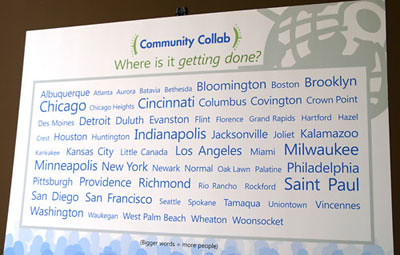 In the community development biz, there are always opportunities to use maps that help illustrate or support your work, whether to show the locations of developments or where your office or programs are.
In the community development biz, there are always opportunities to use maps that help illustrate or support your work, whether to show the locations of developments or where your office or programs are.In the olden days, that meant spending big bucks to have a designer draw a custom map for you.
No more. As Southwest Organizing Project's David McDowell showed us a few weeks ago, with his gut-punch representation of foreclosures in his neighborhood, a map that is loaded with useful information can be created on your own computer and used in print, e-newsletters and online.
 How'd he do it? He told me about Microsoft Streets and Trips, a $40 Windows application that includes attractive and detailed maps of your city and neighborhoods.
How'd he do it? He told me about Microsoft Streets and Trips, a $40 Windows application that includes attractive and detailed maps of your city and neighborhoods. It's not a five-minute job to create a custom map like he did (right), but by using the help menu and futzing around with the various options, you can make something that is nice looking and informative. David imported an Excel file that included the addresses of each foreclosed home, created an outline of the ZIP code area, and then chose a suitable "pushpin" (red circles) to represent each address. The program also imports Access and Outlook files, along with .txt, .csv (comma-separated value), .tab and .acs formats. "We were looking for a way to show leaders in the neighborhood the impact of the foreclosure problem in a visual way," said David.
Then there's Google or Yahoo Maps. They can be built into web sites to automatically generate maps when you insert an address into a data field, as in the directories of the Grassroots web sites that Webitects built for the New Communities Program (see example at top of post).
If you know someone who messes with html code, Google and Yahoo maps can be customized using something called API (I don't know what that means, but it's powerful). Beyond that, there are "mash-ups" that combine maps with other data, automatically, to display information.
Sure, there's work involved. But with these inexpensive tools at our disposal, it's in our interest to learn how to use them.










